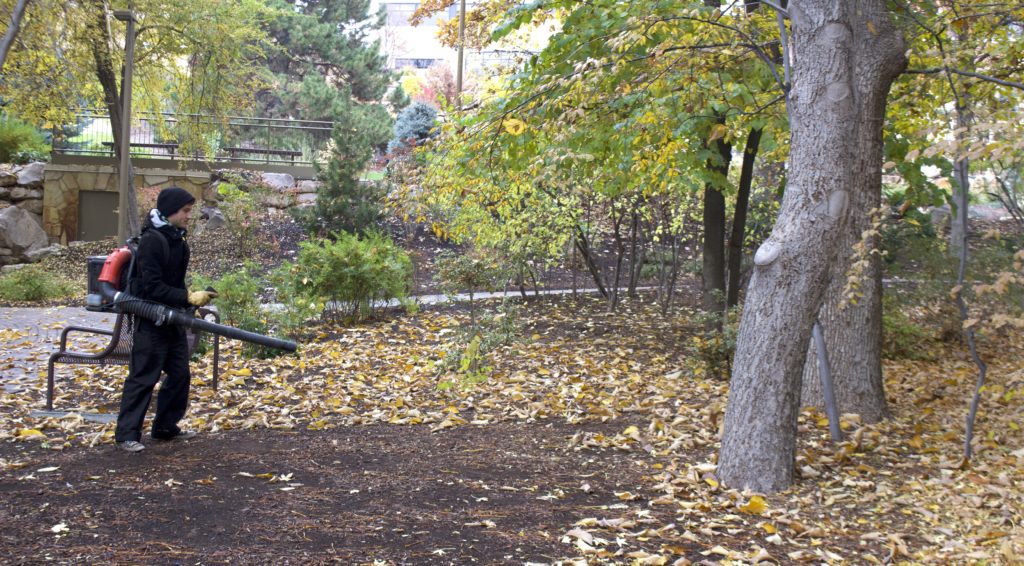
BYU grounds crews work to keep the campus pristine year round. BYU’s 320 acres of maintained landscape are filled with trees, grass and a variety of plant species, according to BYU Sustainability.
Current BYU Grounds Director Glenl Wear began working for the grounds crew as an environmental science student. He has since climbed his way to grounds leadership. Wear has been the grounds director for the past five years.
According to Wear, grounds leadership makes sure the crews have access to resources needed to maintain campus.
Wear said the grounds department’s goal is to create an atmosphere where people can find peace, learning and personal development. He said the grounds department focuses not only on mowing grass and blowing leaves to keep the campus tidy but also on providing students a place to learn outside of the classroom.
“Plant diversification is important for the protection of certain species, but really it’s about teaching and having the opportunity to use our campus as an outdoor classroom for certain colleges,” Wear said.
Wear said grounds keeping on campus changes from season to season. The crew switched from summer maintenance to preparing for fall and winter at the beginning of October.
“In the fall, we are trying to get everything ready and clean. We get flowers planted and everything trimmed and cleaned up and ready for snow this winter,” Wear said.
According to Wear, deer like eating the plants around campus. To preserve the crew’s hard work during the winter, some flower beds on campus are covered with a geotech-style fabric, similar to a shade cloth used in greenhouses. The fabric allows air and water exchange but protects the plants during the cold winter months.
Other flower beds and areas on campus are treated with deer repellent to keep the deer away. The crews also puts small lights and high-pitched sound makers in the beds to keep the deer away.
Wear said maintaining the BYU campus is a constant job. The department employs about 400 students in the spring and summer terms and approximately 250 during fall and winter. Student employees like Tom Leighton work almost daily to get the job done.
Leighton is a student from England. He joined the grounds crew in 2017 while looking for a flexible on-campus job.
“My favorite thing about working for grounds is being around other people. There is a lot of variation working most of the time,” Leighton said. “Being outdoors keeps things refreshing as well because I’m usually using computers when I’m not working, so being outside gives me a break from all of that.”
Leighton said the majority of his work is raking leaves during the fall and shoveling snow during the winter, but summer and spring provide more variety. Leighton said he enjoys mulching during the spring and summer.
Mulching at BYU is done with resources from the BYU recycling center, according to BYU Grounds Solid Waste Supervisor Bill Rudy. Mulch for campus is created using tree clippings and what Rudy calls “food pulp.”
BYU’s food pulp comes from the Wilkinson Student Center restaurant kitchens, the Missionary Training Center cafeteria and the Cannon Center on campus.
“In the kitchen, they have a system where they scrape the plates and it goes into a big disposal — like you have in your sink at home. In your sink, it grinds up the food and it goes to the sewer,” Rudy said. “The ones on campus grind it up and it goes down to a machine that presses the water out and leaves the residue.”
The food pulp is coupled with grass clippings, leaves and wood chips. Rudy said the concoction is then composted into soil for the trees and plants around campus.
Rudy said students can also compost holiday items like pumpkins or Christmas trees.
“If you live on campus or know someone who does, don’t put Christmas trees or pumpkins in the dumpster. If you leave them outside the dumpster, the grounds people will usually come by and throw them in the truck and bring them down here to grind them up,” Rudy said.




